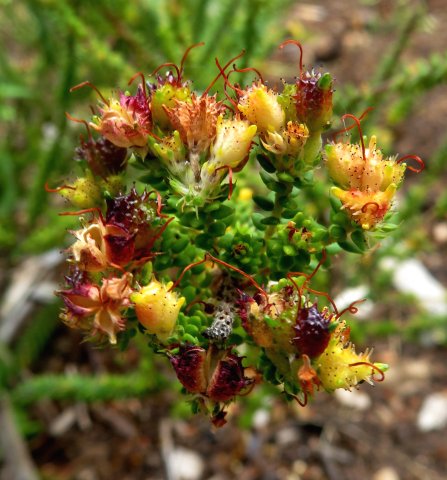Agathosma

Agathosma is a genus of the Rutaceae or citrus family that comprises trees, shrubs and shrublets, rarely herbs. They are usually aromatic and sometimes dioecious.
Agathosma comprises about 150 species of ericoid shrubs and undershrubs. Their leaves are variously positioned, mostly needle-like to roundly shaped and usually gland-dotted on the lower surfaces. The crushed leaves are usually strongly scented.
The white, pink or mauve flowers are often bisexual, growing in stem-tip clusters or solitary, sometimes from upper stem leaf axils. The calyx usually has five parts, the sepals often unequal. The (usually) five petals often have gland-dots on the outside and are sometimes clawed.
There are five stamens, usually with a gland at each tip. Variously shaped staminodes are also present opposite the petals, alternating with the stamens. They are often petal-like in shape with a gland behind the tip. The disc is cup-shaped, the ovary superior. Its (usually) five carpels are almost free and pointed. The fruit is a capsule, each of its usually five parts containing one seed.
The generic name, Agathosma, is derived from the Greek words agathos meaning good in their kind and osme meaning odour, smell or scent, referring to the fragrant oils present in the leaf glands of these plants.
Most Agathosma species are found in Western Cape fynbos, some extend into the Eastern Cape beyond the winter rainfall region and only Agathosma ovata occurs in KwaZulu-Natal and Lesotho.
A. betulina, commonly round-leaved buchu and A. crenulata known as oval-leaved buchu, resprouters of the Western Cape mountains, are among the most widely used traditional medicine species of the region. Used in cosmetics and as a tea, the plants and their essential oils were and are important to many local people. And then there is still buchu brandy. Many buchu species are browsed by stock and game.
The buchu common name shared by several of the species, but also by species of some related genera, is from the Khoi and/or San languages.
The plant in picture is A. riversdalensis showing stem-tip fruit in several stages of ripening (Leistner, (Ed.), 2000; Vlok and Schutte-Vlok, 2015; Manning, 2007; Van Wyk and Gericke, 2000; Andrew, 2017).

